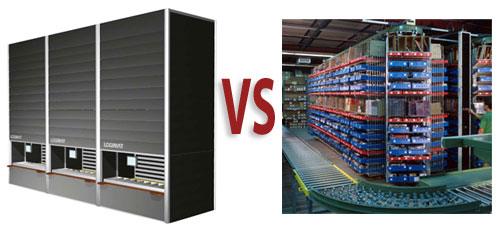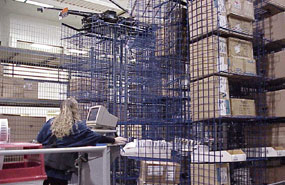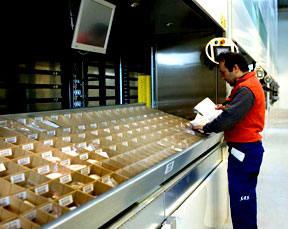Vertical Lift Modules vs. Horizontal Carousels
Which type of "goods to picker" system would work best for you?

When you are considering an automated picking solution, you have lots of choices. One of the more frequent comparisons is between horizontal carousels and VLM’s – vertical lift modules. Both promise similar efficiency gains: they bring products to pickers rather forcing pickers to move to picking stations in shelving or racks. But which is best? That depends on what set of criteria you use, and what’s important to you.
Points of Comparison
- Cost: Horizontals cost less than VLM’s, and it isn’t particularly close – a 40 to 60 percent difference. This figure doesn’t take totes, power lift tables, or any security or safety perimeter fencing that may be deployed into account.
- Storage density & floor space considerations: Horizontals by nature do not utilize the vertical cube as well, and require 50 percent more floor to operate than a vertical solution. Vertical lift modules take the product up, so their footprint is relatively small. Vim’s and vertical carousels are in part designed for better storage density. Of course, both systems leave you with more space than picking bins, racks, or shelves.
- Conveyor integration: Conveyor systems are frequently used with horizontal carousels, both for takeaway and replenishment, to maintain faster picking rates. Vertical lift modules can also interface with conveyor systems, particularly if arranged into a pick pod system. Neither system has an advantage on the other in this scenario.
 Pod picking strategies: Horizontal carousels must be designed into software-driven synchronous pods of 2-4 machines per pod to have any advantage over manual picking. VLMs may be designed as either free standing units or in pods. This gives the VLM more flexibility in many situations.
Pod picking strategies: Horizontal carousels must be designed into software-driven synchronous pods of 2-4 machines per pod to have any advantage over manual picking. VLMs may be designed as either free standing units or in pods. This gives the VLM more flexibility in many situations.- Pick rates: If arranged in a pod of 2 to 4 units, horizontal carousels have a pick rate up to 400 lines per hour. Verticals can achieve approximately 75 lines per hour per machine, 125 per hour for a pod of 2-3 units.
- Manpower requirements (picker requirements): A pod of 2-4 horizontal carousels can be operated by only one person/picker, regardless of order volume. Single machines or pods of vertical lift modules can be operated by either one or multiple operators. These solutions are similar in this regard – it all depends on your operation, throughput needs, and situation.
- Display and picking systems (light trees): Horizontal carousels utilize pick light trees installed between the carousels in a pod (one tree for every two carousels). Vertical lift modules have scrolling pick message displays on each machine. Put light displays are available for either type of machine. Both have their advantages.
- Ergonomics: VLM’s are more ergonomic than horizontal systems because they don’t require the operator to bend or stretch to reach product. With a horizontal, the operator must bend to reach lower bins or stretch to reach overhead bins. Vertical lift modules serve trays up at waist height for ergonomic picking.
 Product slotting: Vertical lift modules are superior when it comes to product slotting flexibility. In a horizontal, you must review SKU locations on a regular basis, and move them to advantageous positions. Verticals can require slotting much less often, and can typically be automated for this function.
Product slotting: Vertical lift modules are superior when it comes to product slotting flexibility. In a horizontal, you must review SKU locations on a regular basis, and move them to advantageous positions. Verticals can require slotting much less often, and can typically be automated for this function.- Batch picking: Horizontal carousels are almost perfect for batch picking, but VLM’s can also execute this process, if not as ideally as a horizontal system.
- Product media (tote/tray) flexibility: VLM’s are more flexible than horizontals when it comes to storage media. Horizontal carousels arrange plastic bins on each shelf to store parts. These are always of fixed, non-adjustable, dimensions. Vertical lift modules typically use metal tray dividers which are adjustable on 1″ centers, meaning reconfiguration requires no new bins, just a quick adjustment.
- Product size variances: The shelves in a horizontal bin are vertically adjustable on 3” centers and their location is set at the time of installation. If product height changes, each shelf must be manually relocated within the bin. The vertical lift module automatically reads the product height on each tray and assigns it to the best location on one inch centers.
- Product security: Because horizontal carousels utilize open baskets/shelves, they’re more susceptible to theft. Many installations fence them in with wire mesh or other security measures, which increases the needed footprint and reduces efficiency in replenishment. Since VLM’s are a closed box, they can be locked out and don’t require fencing.
- Product protection/containment: Same scenario as above. Products in open bins can be hit with dust or other airborne contaminants. In a VLM, they are contained in the box, shielded from dust, fumes and other potential contaminants.
Tags: warehouse technology, Automation, picking systems
Scott Stone is Cisco-Eagle's Vice President of Marketing with 35 years of experience in material handling, warehousing and industrial operations. His work is published in multiple industry journals an websites on a variety of warehousing topics. He writes about automation, warehousing, safety, manufacturing and other areas of concern for industrial operations and those who operate them.




 Pod picking strategies: Horizontal carousels must be designed into software-driven synchronous pods of 2-4 machines per pod to have any advantage over manual picking. VLMs may be designed as either free standing units or in pods. This gives the VLM more flexibility in many situations.
Pod picking strategies: Horizontal carousels must be designed into software-driven synchronous pods of 2-4 machines per pod to have any advantage over manual picking. VLMs may be designed as either free standing units or in pods. This gives the VLM more flexibility in many situations. Product slotting: Vertical lift modules are superior when it comes to product slotting flexibility. In a horizontal, you must review SKU locations on a regular basis, and move them to advantageous positions. Verticals can require slotting much less often, and can typically be automated for this function.
Product slotting: Vertical lift modules are superior when it comes to product slotting flexibility. In a horizontal, you must review SKU locations on a regular basis, and move them to advantageous positions. Verticals can require slotting much less often, and can typically be automated for this function.